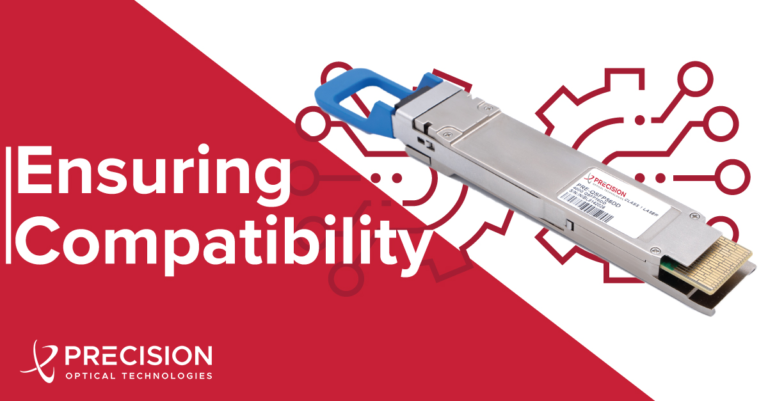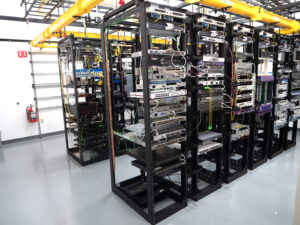
Ensuring Compatibility with Multi-Platform Optics

Multi-Platform Optics: How We Ensure Compatibility
Pluggable transceivers have revolutionized fiber optic communications and are key to the millions of electro-optical interconnects we take for granted every day. The compatibility of a transceiver, with its host platform, is critical to ensuring reliable networks while minimizing OpEx and CapEx. But how often do we think about what it takes to make these devices truly compatible and “pluggable”? At Precision OT, we think about compatibility a LOT. Pretty much around the clock in fact, which is the way networks must perform. While traditional NEM (Network Equipment Manufacturers) transceivers are not designed to function across multiple platforms and multi-platform operation is not supported, Precision OT devotes a lot of time and expertise to ensure our optics are optimized for plug and play operation in whichever platforms our customers specify.
What is compatibility and why is it important?
In today’s network system deployments, a wide range of NEM host platforms are used. Compatibility refers to the ability of one specific network host, software, etc. to interoperate/communicate with another. What makes a transceiver compatible is a combination of several factors largely rooted in the work that’s been done over the last few decades on transceiver Multi-Source Agreements (MSAs). In short, MSAs help define the mechanical form factor, the electrical specifications, initialization, timing and the EEPROM memory map, and the I2C that is the management interface between a transceiver and the host platform.
Off-the-shelf transceivers or “base parts” have hardware that is pretty standard and defined in MSAs, with some differences between vendors in terms of quality and design. The software (SW) and firmware (FW) in a transceiver can vary quite a bit from vendor to vendor. SW/FW is basically the way a transceiver has been programmed to behave (ie., things like timing when initializing) and this can affect the behavior of the transceiver when plugged in a host platform. Transforming the transceiver from a base part into one that is compatible with one or perhaps multiple platforms takes careful systems engineering know-how and expertise from start to finish. To be considered compatible, a transceiver must be able to be plugged into a host platform, initialize, and be recognized properly so it can function without faults.
How Does Precision OT Ensure Compatibility ?
Precision OT’s system engineers work closely with our customers to understand their unique network needs. By custom coding the internal memory map of the transceiver, we prepare the optic to be read and to interact with specific host platforms and/or multiple host platforms. In order to do this, a great deal of knowledge and experience with 100’s of SW versions from numerous host platforms has been accumulated and developed by the POT Systems and Field Application Engineering teams.
How do we ensure compatibility across multiple network platforms? With cutting-edge programming, diagnostics and testing technologies in our lab and at our customer facilities.
Precision OT’s Engineering teams’ expertise includes:
- NEM platform interoperability technical experts
- On-site systems engineers assigned to customers
- Integration testing and direct involvement with customer engineering teams
- System design support (CWDM/DWDM, Mobile Backhaul, Datacenter physical Interconnectivity, etc..)
- Support for the life-cycle management of new NEM host platforms, software and hardware
- Remote lab support/testing capability
- Multi platform integration testing/compatibility and documentation
Each of our transceivers are tested and verified in several areas:
- EEPROM compatibility for the intended platform
- Optical and electrical characterization
- Physical Link test
- For CWDM/DWDM devices, output to our OSA to confirm channelized (wavelength) specifications
- Temperature testing for Industrial and Hardened temp. transceivers
In the end, our multi-platform optics are custom engineered to meet the requirements of our customer’s network design. There are several advantages to using multi-platform optics, which include cost savings, minimizing sparing and simplifying operational deployment. Optics that are multi-platform compatible require lower sparing and inventory levels. They also allow for simplicity of deployment; a single part number can be ordered, stocked, and deployed, which eliminates the requirement to track multiple part numbers across procurement, warehouses and in the field (reduced SKUs). Precision OT Engineers work closely with customers throughout the life-cycle of their network, paying close attention to new SW versions and new HW being deployed to ensure compatibility and seamless network operations.







